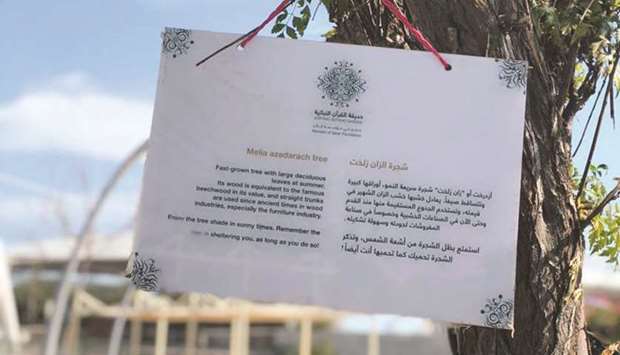Qur’anic Botanic Garden (QBG), a member of Qatar Foundation, was inaugurated more than a decade ago, during Ramadan on September 17, 2008, by Her Highness Sheikha Moza bint Nasser, Chairperson of Qatar Foundation, who planted our garden’s very first tree, the Sidra tree, the symbol of Qatar Foundation.
Since that day, QBG has emerged as an important contributor to Qatar’s sustainable development and food security goals, a respected source of information for the community on environmental conservation, gardening, and potential medicinal plants, and a key driver of environmental restoration in Qatar.
It remains the only garden in the world to exhibit all 60 plant species mentioned in the Holy Qur’an, Hadith, and Sunnah. Every plant growing in our garden is central to the Islamic faith and elucidates Islamic ethics and principles. Among our garden’s most prominent plants are the Sidra tree, the Samor tree, and the Ginger plant.
The Holy Qur’an mentions the Sidra tree — also known by its botanical name, Ziziphus spina- christi Willd, Sidr — as one of the plants of paradise. In addition to growing in the Arabian Peninsula, the Sidra tree can also be found in India, Pakistan, Ethiopia, Egypt, Libya and Sudan.
It symbolises beauty, fortitude, and determination, and is an important symbol of Qatar’s heritage. For centuries, it has flourished in the country’s deserts and provided a source of refuge for travellers from the blazing desert sun. In addition, its fruits, leaves, and honey, believed to have healing qualities, were a source of nourishment and comfort for the community.
The Umbrella Tree, which also goes by the name of the Samor Tree or Acacia Tortillis, grows in Qatar’s drylands and is mentioned in Verse 18 of Surat Al-Fath in the Qur’an (“Certainly Allah was pleased with the believers when they pledged allegiance to you, [O Muhammad – PBUH], under the tree, and He knew what was in their hearts, so He sent down tranquillity upon them and rewarded them with an imminent conquest”) is another important plant in our garden. The tree can be found in Qatar and other parts of the Arabian Peninsula and Africa.
Historically, the Umbrella Tree was used as fodder for desert grazing animals, as well as a combustible for fire since it does not smell as strong as other types of wood. In addition, when mixed with sulphur, it was used to manufacture gunpowder. Through the consumption of its yellow flowers, bees produce one of the highest quality honeys, known as Alborm or Almaraya.
Due to rapid development, the prevalence of this tree declined, but collaborative restoration efforts made by QBG and the Ministry of Municipality and Environment have begun reversing this trend, making a positive contribution to the country’s sustainable development. Moving forward, we plan on significantly and systematically expanding our restoration and conservation projects.
Ginger plants can also be spotted around our garden. They are native to countries such as China, Japan and India, but are now also grown in parts of the Middle East, Africa and South America.
Widely known around the world for its health benefits, in the Qur’an, ginger is said to be one of the drinks that will refresh the believers in paradise. The medical benefits of ginger can be traced back to ancient times in Sanskrit, Chinese, Greek, Roman and Arabic medical literature. The sidra tree, umbrella tree and ginger plant, mentioned earlier are only a few of the 60 plants that our garden contains. They form an indispensable element of our work in serving the community.
Community is at the heart of what we do. That is why QBG regularly hosts events, seminars, workshops, exhibitions and campaigns that bring the public together with well-respected environmental experts, facilitating knowledge exchange and an increased sense of responsibility towards the planet. For instance, as part of the QBG Ghars Campaign, we pledged to plant 2,022
trees in the leadup to the FIFA World Cup Qatar 2022. The campaign is now well on track to successfully complete this challenge, with close to 2,000 trees already planted.
In addition to its impactful and interactive Young Botanist, Fun and Learn, and Food Security educational programmes and initiatives for schoolchildren of all ages, which focus on environmental sustainability and conservation, QBG, utilising its environmental and botanical know-how, has collaborated with educational institutions to create academic and educational courses. We have also organised an array of educational field trips and workshops, where students have been able to gain both theoretical and practical knowledge about modern agricultural techniques used in Qatar and other countries.
Aligned with the United Nations’ Sustainable Development Goals aimed at achieving a better and more sustainable future for all and QBG’s plant conservation strategy, we have contributed
to the rehabilitation of plant nurseries in Qatar, following a detailed environmental study and then replanting them with trees, helping to reduce carbon emissions in the country.
Locally and globally, QBG continues to seek out fruitful partnerships and collaborations with diverse organisations. Among the entities that QBG currently collaborates with are the Ministry of Municipality and Environment, Qatar Development Bank, Agrico Agricultural Development, ASTAD Project Management, the Behavioural Healthcare Center in Doha, the Nahmeeha Initiative of Kuwait, the Royal Botanic Garden of Jordan, and the International Union for Conservation of Nature. QBG’s joint work with such entities helps create a more environmentally conscious public.
It is truly an honour to see that QBG is flourishing like a tree with deep roots and has become a driving force in cultivating a collective sense of responsibility towards the environment. We look with hope and optimism towards the future, and will continue doing everything in our power to create a greener Qatar and healthier planet for the generations to come.
* Fatima al-Khulaifi is the Director of Qur’anic Botanic Garden

Qur’anic Botanic Garden has become a driving force in cultivating a collective sense of responsibility towards the environment.
